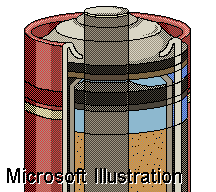
| |
 |
![]()
 Where idle cars will provide a wealth of useful material; the battery will be
useless, especially if it's been just setting there for a very few months. Auto
batteries are designed to provide a high output for a short time so as to turn the
car's starter. They do not work well, even after a full charge, at providing a
small output over a period of time. Try using a car battery with a trolling
motor in a boat. You will find yourself stuck away from the boat trailer long
before you anticipated. That is why they make marine batteries. They usually
won't start your car but will run that trolling motor all day! They are also used
in RVs for the same reason. They will provide a relatively small output for a
longer period of time.
Where idle cars will provide a wealth of useful material; the battery will be
useless, especially if it's been just setting there for a very few months. Auto
batteries are designed to provide a high output for a short time so as to turn the
car's starter. They do not work well, even after a full charge, at providing a
small output over a period of time. Try using a car battery with a trolling
motor in a boat. You will find yourself stuck away from the boat trailer long
before you anticipated. That is why they make marine batteries. They usually
won't start your car but will run that trolling motor all day! They are also used
in RVs for the same reason. They will provide a relatively small output for a
longer period of time.
One other very important thing to remember about both of these types of batteries; you gotta use um or loose um. That is, whether the battery is initially fully charged or almost depleted, if it just sets there for more than 2 or 3 months it will self destruct. By that I mean that it will no longer take on a charge, or store the same amount of electricity that it was designed for. Keep in mind that I'm talking about the kind of batteries found in cars, boats, RVs, etc., that is, lead acid batteries. If the battery just sits there, a chemical reaction takes place inside the battery that coats the lead plates with a sulfur compound that I can't recall at the moment. Any area on the lead plate(s) that become coated are then no longer useful to the battery; they might just as well have been removed. Thus the battery has less capacity to store electric power when being charged.
For this reason I think it would be important that someone with the know how design a build-it-yourself lead-acid battery. Then batteries from cars could be used as raw material. The sulfuric acid may be able to be reused (although it may be tied up in the useless compound that now coats the lead plates). The sulfuric compound that was making them useless could be scraped off the lead plates. Perhaps someone can tell us how to recover the sulfur from the scraped away material and make pure sulfuric acid again.
Only a few years ago, lead-acid batteries were sold differently. The box contained the battery, but the battery did not contain any sulfuric acid. The acid was separately packaged in a plastic container. To activate the battery you had to add the acid to each of the cells (remember when batteries had little screw on caps?). These batteries had virtually unlimited shelf life before being "activated". Now we have "sealed" batteries that already contain the acid. Most of these "sealed" batteries, however, are not actually sealed. With a screwdriver one can pry away the plate that runs across the top of the battery exposing those little holes for each of the cells.
If one were to obtain relatively fresh lead acid batteries, remove the "seal", and dump the acid into a suitable container, and then flush all the cells with distilled water and replace the "seal" strip; the battery could then be stored away without it's destroying itself. When it's time comes to be placed into service one needs only to replace the acid and charge it up. Note that the above will not work for a type of led-acid battery called a "gel cell"; however these batteries will not be often found as they are used in mostly special applications requiring extreme portability such as a battery belt for video camera lights used by news crews and are used now and then by ham radio operators for backup power in emergency support operations.
Offered by Ron.